Gotthard Base Tunnel

Bombardier is building the Twindexx for Swiss Federal Railways. This largest rolling stock order in SBB's history is expected to begin service starting in 2013. Click on the image to learn more.
  Switzerland Switzerland
This is my fourth article dealing with Switzerland in 2011. Check out the other three articles about the Rhätische Bahn (RhB), the Dampfbahn Furka-Bergstrecke (DFB), and the Matterhorn Gotthard Bahn (MGB) located in the Slim Archive. For a very brief description of the country known as Switzerland click on the logo of the Swiss cow to the right.
 Introduction Introduction
 This month's article has been abridged from an English information booklet provided by the AlpTransit Visitor's Centre located at Erstfeld, Switzerland. AlpTransit Gotthard Ltd., a wholly owned subsidiary of the Swiss Federal Railways (SBB), is the company constructing the 57 kilometre long (35.4 miles) Gotthard Base Tunnel between Erstfeld and Bodio. Presently it is the world's longest rail tunnel. Two additional tunnels, Zimmerberg (20km or 12.4 miles long) to the north, and Ceneri (15 km or 9.3 miles long) to the south of the Gotthard Base Tunnel have been left out of this article but they are part of the overall construction project. AlpTransit is expected to hand over the completed tunnel to Swiss Federal Railways (SBB) for operation in December 2016. The final breakthrough in the west tube of the double tube tunnel occurred on Wednesday, 23 Mar 2011 at 12:20. As of October 2010 eight workers have died during construction. This month's article has been abridged from an English information booklet provided by the AlpTransit Visitor's Centre located at Erstfeld, Switzerland. AlpTransit Gotthard Ltd., a wholly owned subsidiary of the Swiss Federal Railways (SBB), is the company constructing the 57 kilometre long (35.4 miles) Gotthard Base Tunnel between Erstfeld and Bodio. Presently it is the world's longest rail tunnel. Two additional tunnels, Zimmerberg (20km or 12.4 miles long) to the north, and Ceneri (15 km or 9.3 miles long) to the south of the Gotthard Base Tunnel have been left out of this article but they are part of the overall construction project. AlpTransit is expected to hand over the completed tunnel to Swiss Federal Railways (SBB) for operation in December 2016. The final breakthrough in the west tube of the double tube tunnel occurred on Wednesday, 23 Mar 2011 at 12:20. As of October 2010 eight workers have died during construction.
 The High-Speed Link With Europe The High-Speed Link With Europe
By constructing the New Rail Link through the Alps (NRLA), Switzerland is integrating itself into the growing European high-speed network. The future rail link will bring the economic centres on both sides of the Alps closer together, this flat link under the Gotthard opens up new prospects for rail traffic through the Alps.
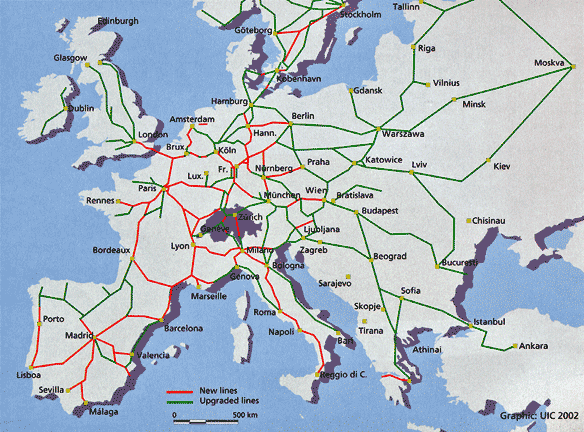
In the last 20 years a pan-European network of high-speed railways has come into existence and is steadily growing. Depending on how projects develop, there may be up to 20,000 kilometres of high-speed lines in Europe by 2020. With such a well-developed railway system, passenger travel by train becomes an attractive alternative to the car. If the train journey time between two cities can be reduced to under four hours, the railway also offers serious competition to flying.
The high-speed systems in Europe are being expanded further, and coordination between them is being improved. The goal is for signalling systems and train control systems to be standardized across national boundaries. The resulting inter-operability is a key factor for efficient operation.
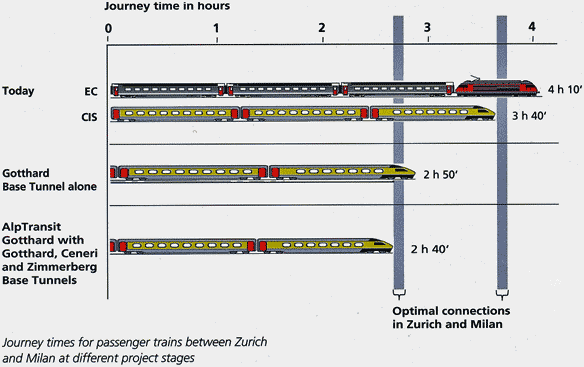
 A New Era in Transalpine Transportation A New Era in Transalpine Transportation
Transalpine freight traffic by road and rail has increased continuously in the EU and Switzerland. International trade is growing faster than domestic trade. Demand for freight transportation to and from Italy will continue to rise steeply.
European freight traffic across the Alps today mainly burdens the roads. Transalpine road traffic doubles every eight years whereas rail traffic remains constant. Raising the weight limit from 28 to 40 tonnes has resulted in fewer trucks bypassing Switzerland via Austria and France. Transit traffic will continue to increase. Freight traffic in the entire Alpine region will grow by as much as 75% by 2010 according to a study by the EU Commission.
If this trend continues it will endanger the quality of the environment for ourselves as well as future generations. Earlier than other nations, Switzerland has therefore incorporated into its constitution a traffic policy aimed at making mobility as environmentally compatible as possible. However, such traffic volumes are more than the 130-year-old Gotthard route can accommodate. Only by upgrading its railway infrastructure can Switzerland meet the rising demand for freight transportation and the increasing needs of customers. Thanks to the two NRLA routes through the Gotthard and Lötschberg, annual freight transportation capacity will be more than doubled from 20 million tonnes now to around 50 million tonnes. That is sufficient to cope with the forecast increase. Higher capacity and quality bring major benefits for customers.
 Modernizing the Railway Infrastructure Modernizing the Railway Infrastructure
Transferring traffic from road to rail is a step towards Switzerland's goal of sustainable, environmentally compatible, transportation. To achieve this goal, enormous investments in public transport infrastructure are needed.
Switzerland's existing railway network is being expanded and modernised with four key objectives: making Switzerland more attractive to business, improving environmental compatibility, ensuring that public transport can be financed, and embedding the Swiss transportation infrastructure in the European network.
Four projects will achieve these objectives: AlpTransit, Rail 2000, integrating Switzerland into the European high-speed network, and noise reduction on existing lines and rolling stock. The demand for freight traffic will be met mainly by expanding the north-south axis to make it more attractive in the domestic market, as well as to provide more efficient connections between economically strategic areas of Switzerland, Italy, and Germany.
Passenger traffic today stays mainly within Switzerland, or travels between Switzerland and Italy, rather than crossing the country from border to border. However, implementation of a pan-European high-speed railway network is proceeding rapidly, business is becoming increasingly international, and cross-border mobility is growing in significance. Against this backdrop, integration into the European high-speed railway network is vitally important for Switzerland.
Freight traffic will enter a new era when high-performance freight trains travel at speeds of up to 160 km/h. Thanks to these high speeds, freight trains will not have to stop so often, or so long, to let passenger trains overtake.
Thanks to AlpTransit the north-south rail link will become an ultramodern, highly efficient, traffic carrier offering increased transportation capacities and shorter journey times. In addition, it will guarantee sustainable, environmentally friendly, management of mobility for the ever increasing volumes of traffic.
 Flat All the Way and Faster Too Flat All the Way and Faster Too
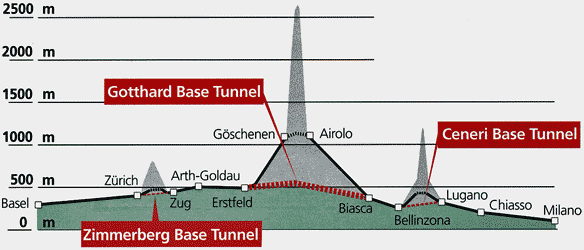
Creation of a flat rail link on the Gotthard route makes freight transportation more productive, while passenger traffic benefits from massively shorter journey times.
Construction of base tunnels under the Gotthard and Ceneri creates an ultramodern flat rail link whose highest point at 550 metres above sea level is no higher than the city of Berne. This is much lower than the highest point of the existing route through the mountains at 1,150 metres. Gradients will be no steeper than where the railway crosses the Jura mountains through the Hauenstein tunnel (Basel-0lten) or the Bbzberg tunnel (Basel-Brugg). The route through Switzerland becomes flatter and 40 km shorter. Italy and Germany come much closer together.
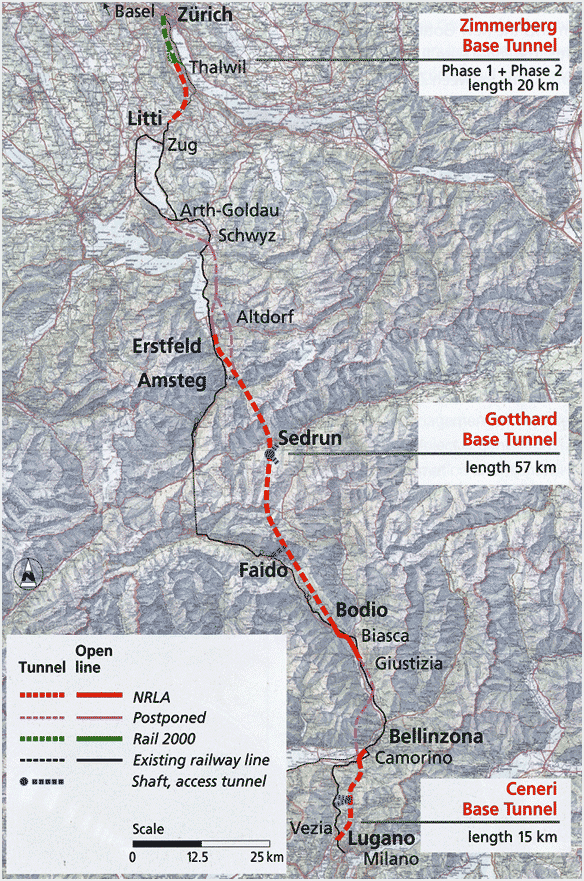
Freight trains travelling on the flat route can be longer and pull up to twice today's weight, 4,000 tonnes instead of 2,000 tonnes. They will be up to twice as fast, too. The fastest freight trains will have a top speed of 160 km/h. Trains like this cannot be used on existing Alpine routes because of the steep gradients and tight curves. When the flat route is complete, it will be possible to transport an equal volume of freight with fewer locomotives, personnel, and less energy.
 50 Years of Planning 50 Years of Planning
The idea of building a Gotthard base tunnel is not new. The first idea was already put forward in 1947. Half a century after the first project of 1962, the world's longest railway tunnel will finally go into operation. Needless to say, those 50 years have left their mark on the project.
Acceptance in 1992 of the proposals for the New Rail Link through the Alps (NRLA) provided the basis for planning. Acceptance in 1998 of the Heavy Vehicle Tax (HVT), as well as the proposal for modernization of the railways, finally cleared the way for construction. In 2016, the world's longest railway tunnel will start to go into operation.
The first project for a base tunnel through the Gotthard was formulated by the Swiss Federal Department of Home Affairs in 1962. The plan envisaged a double-track tunnel running in a straight line from Amsteg to Giornico and accessed from two intermediate headings. It would be 45 km long with an overtaking track in the middle. Trains would travel through the tunnel at a maximum speed not much lower than is planned today, up to 200 km/h.
Other aspects of the first plan were radically changed. Lively discussion centred on the tunnel system. In a report published in 1971, the Committee for a Railway Tunnel Through the Alps of the Swiss Federal Department of Environment, Transport, Energy, and Communications concluded that a two-track tunnel, possibly with some sections split into two single-track tunnels, would be the best solution. The choice between a two-track tunnel with service tunnel or two single-track tunnels (with or without service tunnel) was only decided much later, in 1995. The final winner was a combined solution: two single-track tunnels with no service tunnel but linked by connecting galleries about every 180 metres so that each tunnel can serve as an escape route for the other. There are also two multifunction stations and crossovers.
 Two Tunnels and That's Not All Two Tunnels and That's Not All
The Gotthard Base Tunnel has two single-track tunnels which are linked to each other by connecting galleries. Two multifunction stations at the one-third-way points of the tunnel house crossovers, emergency stop stations, and technical installations for railway operations and ventilation.
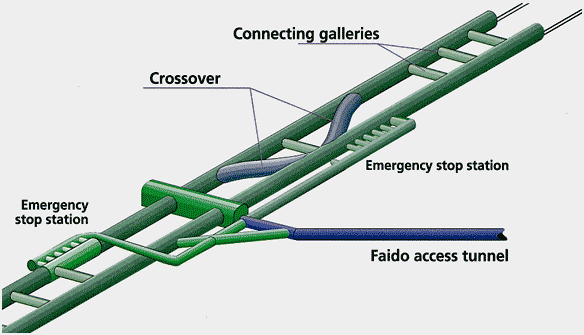
In 1995, when the Swiss Federal Council approved the preliminary plan for the Gotthard Base Tunnel, it spoke in favour of a tunnel system with two single-track tunnels. The two rail tunnels are about 40 metres apart and joined approximately every 325 metres by connecting galleries. Two double crossovers allow trains to change from one tunnel to the other, which may be necessary to allow maintenance work, or if an incident occurs. Trains can change tunnels in the multifunction stations at Sedrun and Faido. These stations also house ventilation equipment, technical infrastructure, safety and signalling systems, as well as two emergency stop stations which are directly linked by separate access tunnels. The emergency stop stations provide a place for trains to stop in an emergency from where passengers can escape and be evacuated. To reach the other railway tunnel, passengers do not have to cross railway tracks, climb steps, or use lifts. Should an incident occur, smoke is sucked out of the affected tunnel and fresh air blown into the emergency stop station through the side tunnels and connecting galleries. A slight overpressure is enough to prevent smoke entering the escape route to the unaffected tunnel. From the emergency stop station an evacuation train transports passengers out of the tunnel. if a train stops before it reaches an emergency stop station, passengers can use the connecting galleries to escape to the other railway tunnel.
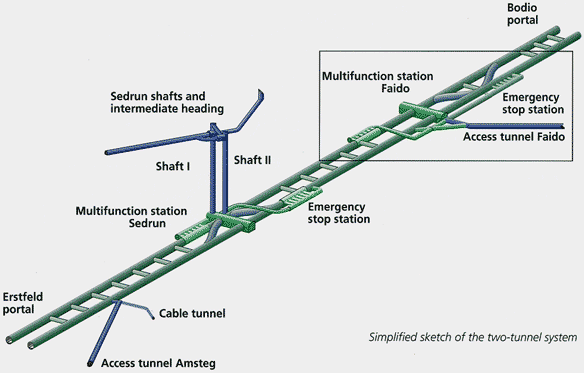
 Construction Concept Construction Concept
The route of the Gotthard Base Tunnel between Erstfeld and Giustizia/Osogna was determined by the Swiss Federal Government in April 1995. To optimize time and costs, construction of the tunnel is proceeding simultaneously on five separate sections of different length.
In the planning phase of the project, answers were found to the questions of when, where, and in what sequence construction must take place to optimise construction time and costs. The concept for the Gotthard Base Tunnel is to drive five separate sections of different length simultaneously. For the construction project, two alternative approaches were developed using two methods of driving, tunnel boring machines or drilling and blasting.
Construction work began on the Piora test bore system in 1993, which in 1998 delivered clear results regarding the geology of the Piora syncline. Starting in 1996, all necessary adits and shafts were constructed. Then, the railway tunnels themselves, the cross-passages between them, and the multifunction stations are being built.
The north portal of the tunnel at Erstfeld is reached from the existing main line of Swiss Federal Railways via an overground approach line from Rynacht-Altclorf.
The Erstfeld section is the most northerly section of the Gotthard Base Tunnel. It includes an underground branch-off to allow future extension of the tunnel to the north without having to interrupt train services. The first part of the tunnel was constructed by digging an open trench which was covered over after completion. The rest of the Erstfeld section was cut with tunnel boring machines.
The Amsteg section is the second section from the north. A 1.8 km adit and a construction tunnel were driven by drilling and blasting to the position of the railway tunnels where assembly caverns were excavated. From these caverns, two tunnel boring machines started cutting south towards the Sedrun section in 2003.
The Sedrun section is reached from the surface through a 1 km long access tunnel and two parallel vertical shafts 800 meters deep. This section is also the site of one of the two multifunction stations, which will house technical installations, emergency stop stations, and track crossovers. Excavation of the railway tunnels to the north and south from the bottom of the shafts began in 2004 using drilling and blasting. Tunnel boring machines could not be used because of the geological conditions.
The Faido section is reached from the surface through a 2.7 km long adit with a gradient of up to 13%, and for construction logistics is linked to the Bodio section. The second multifunction station is located in the Faido section. Because of the geological conditions, it was constructed further south than originally planned. When the two tunnel boring machines cutting from Bodio arrived here they were repaired and modified before continuing north towards the Sedrun section.
The Bodio section is the longest section of the Gotthard Base Tunnel. The first part of the section was constructed above ground, and then through loose rock, before sufficiently solid rock was reached to allow driving with tunnel boring machines. To allow faster construction of the underground assembly caverns for the tunnel boring machines, a bypass tunnel was dug round the site of the portal. From the assembly caverns, two tunnel boring machines started cutting north towards Faido in 2003.
From the south portal at Bodio, an overground approach line linked the Gotthard Base Tunnel to the existing main line of Swiss Federal Railways at Giustizia/Osogna.
 Driving the Tunnel Driving the Tunnel
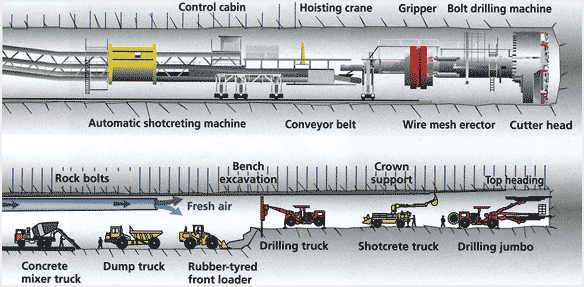
The rate of advance depends mainly on the geology. The speed of excavation, on the other hand, depends on the performance of the machines used, the people who operate them, and the number of shifts worked.
The geological forecast provides information about the rock conditions to be expected below ground. Based on this forecast, the engineers divide the rock into classes. The class of rock determines the rate of advance which can be expected. In good classes of rock, daily advance rates of more than twenty metres can be achieved, but if the rock class is poor, the rate may drop below one metre per day.
| | TECHNICAL TERMS
Rock pressure: Creation of a hollow space inside the mountain causes a shift in stresses. High overburdens in soft rock cause deformation of the hollow space. To prevent squeezing of the hollow space when a tunnel is constructed, anchors, shotcrete, and steel arches are used to create a counter pressure.
Corrosive groundwater: Groundwater containing chlorides or sulphates which impair the durability and usability of construction materials. Concrete exposed to water containing sulphates swells unless special cement is used. Anchors are corroded by chlorides unless they are appropriately protected.
Sintering: A substance dissolved in water (for example calcium carbonate in drainage pipes) decomposes by chemical action and forms mineral deposits. Over time, sintering reduces the cross section of the pipe and causes blockages.
|
The slower advance rate is mainly because of the work involved in supporting the excavated section. The more measures that are needed to provide support, the longer it takes until the next metre of tunnel can be tackled. Whereas in compact gneiss the tunnel can be advanced and supported simultaneously, in poor rock every metre that is blasted, or bored, has to be supported immediately. Inserting steel arches is very time-consuming, and if the rock is particularly brittle, a thicker layer of shotcrete has to be applied.
State-of-the-art technology allows driving the tunnel to be largely mechanized. However, this also places greater demands on the tunnellers who operate the machines. Specialists are needed. It is no longer enough to have a feeling for the rock and to know how to use explosives. New technical machinery must be operated, computer-controlled tunnel boring machines (TBMs), drilling jumbos with multiple drilling heads, muck vehicles, laser instruments, and hydraulically operated steel tunnel liners.
The right specialists in the right places work together in shifts as a strong team. Shift operations are planned to the last minute of a 24-hour day.
The choice between drilling/blasting and TBM depends on the expected rock conditions.
Drilling and blasting is a highly flexible construction method. The length of excavation and use of supporting means (e.g. shotcrete, anchors, steel inserts, reinforcing mesh) can be continuously adapted to the conditions encountered. With drilling and blasting, an average advance rate of between 6 and 10 meters per working day can be achieved.
Driving by TBM is substantially more difficult to adapt to changing conditions. The complete driving unit (TBM and backup train with a total length of up to 400 metres) is a permanently assembled, largely rigid unit, with mostly standardised procedures.
The Drilling and Blasting Cycle
Three shifts are worked of 8 hours each. Drill, charge, detonate, ventilate, support, and muck. Under good rock conditions, these operations are completed in one eight-hour shift. In poor conditions, particularly the support phase requires more time, and the removal of muck (blast debris) can only start when supporting work is complete. The cycle may then spread over several shifts.
In good rock conditions, a TBM can cut from 20 to 25 metres per working day. In more difficult conditions, daily rates of progress are much slower. In some cases, only a few metres per day can be cut and supported. Not infrequently, additional measures may also be needed.
The investment costs for a TBM are much higher than for driving by drilling and blasting. Procurement and installation of a TBM also generally take much longer than the equipment for drilling and blasting.
The decision whether to excavate a section by drilling and blasting or with a TBM therefore depends mainly on the range of construction conditions expected, the length of the section, and the total amount of time available for construction. The greater the diversity of construction conditions and the shorter the section, the greater the advantages of drilling and blasting, and vice versa.
The geology remains an unknown no matter how much exploration is done, and can present surprises right up to the last metre. Despite the high degree of mechanisation, taking the right decisions inside the tunnel still depends on people. The experience of experts, whether geologists, blasting specialists, or shift workers, is irreplaceable.
The Tunnel Boring Machine Cycle
Three shifts are worked of 8 hours each. Shifts 1 and 2 - the TBM bores a length of two metres and automatically clears out the cut rock. Supporting with anchors, shotcrete, or steel arches is done from the machine itself. Then the machine moves forward by the length it cut. This cycle is repeated several times each shift. Shift 3 - The TBM is cleaned, serviced, and repaired. Worn cutters are replaced.
 Supports and Linings Supports and Linings
A railway line under the mountains requires a higher standard of materials technology because repairs cost much more than for an overground line. The construction materials for the new Gotthard Rail Link must therefore have a long lifetime.
The correct choice of materials for supporting, sealing, and lining the tunnel is vital to ensure the safety of the tunnellers at all times as well as trouble-free operation for 100 years.
Faults and other areas which make tunnel construction difficult can be prepared before excavation of the tunnel itself begins. When driving through rock, injections are frequently used. The injections are usually of cement, and serve to bind the rock before it is excavated, as well as reducing its permeability to water. They also provide long-term stability.
Initial supports prevent rock falling from the roof before the permanent supporting measures are installed. Depending on the geology, tunnel constructors have a range of supporting means at their disposal. Anchors, shotcrete, and steel arches can be combined in variable numbers and strengths. The initial support is in direct contact with the rock, and therefore suffers the greatest exposure to the effects of rock and groundwater.
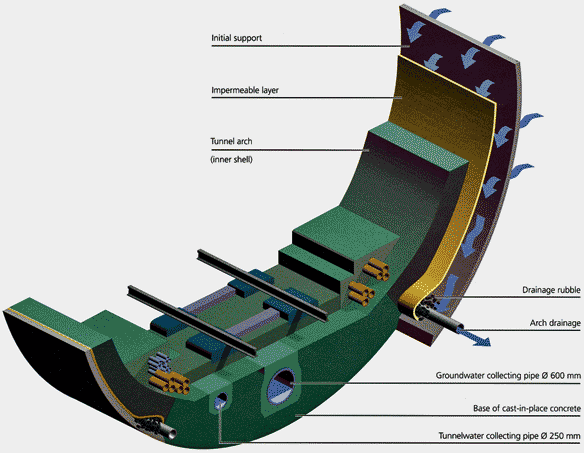
The water management system in the Gotthard Base Tunnel directs groundwater via surface drainage into drainage pipes and prevents direct ingress of water into the tunnel by means of a sealing foil. This system meets railway engineering requirements at the same time as preventing a build-up of groundwater pressure.
The high speeds of the trains require a smooth inner lining of concrete. Because the initial support only provides support for a limited period of time, the inner lining must assure safe support on its own and therefore be at least 30 centimetres thick. In areas where the inner lining is subjected to heavy stresses, it is reinforced with steel.
 Safety Concept in the Tunnel Safety Concept in the Tunnel
Anyone hoping for an exciting adventure when crossing the Alps by train will find the journey disappointing. Thanks to the safety measures in the tunnels of the new Gotthard Rail Link, incidents are practically ruled out.
Special Aspects Affecting Safety
· The length of the tunnels (Gotthard 57 km, Zimmerberg 20 km, Ceneri 16 km);
· The great depth of overlying rock in some places (up to 2,300 metres in the Gotthard Base Tunnel) causing exceptional rock pressure and climatic conditions;
· Speeds up to 250 km/h;
· A moderate to high train density with a large proportion of freight trains;
· Its major international importance as a transalpine rail link which calls for exceptionally high standards of reliability and safety.
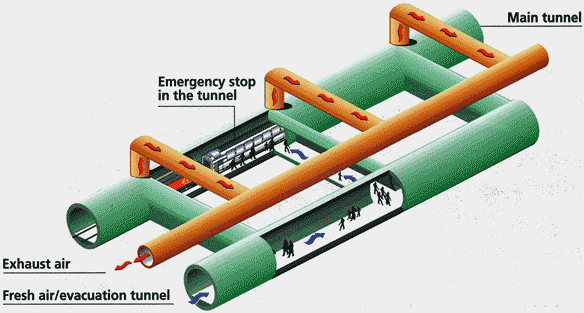
 Public Involvement Through Open Information Public Involvement Through Open Information
The new Gotthard Rail Link is the most far-reaching environmental project Switzerland has ever known. Public interest is correspondingly strong. As constructor, AlpTransit Gotthard Ltd. aims to provide competent, complete, and transparent information on developments, progress, milestones, challenges, and solutions at all times.
The Internet is the fastest medium for exchanging information. AlpTransit Gotthard Ltd. maintains an extensive multilingual web site which is continuously updated. The latest information on the status of work will be found there, along with many fascinating details about construction of the new Gotthard Rail Link.
AlpTransit Gotthard Ltd.
Zentralstrasse 5
6003 Lucerne Switzerland.
www.alptransit.ch
 News Articles News Articles
12 May 2010 - SBB Places Major Order
21 Oct 2010 - Swiss Celebrate Completion of World's Longest Railway Tunnel
28 Feb 2011 - SBB Creates a Smarter Railroad with IBM and Alcatel-Lucent
30 Mar 2011 - Lötschberg Tunnel Celebrates 100 Years
30 Mar 2011 - Rail Passengers Grow While Earnings Dip
14 Apr 2011 - The Boeoegg Explodes Atop Zurich Bonfire
28 Apr 2011 - ABB Lands Gotthard Base Tunnel Contract
8 May 2011 - Federal Railways Say No to Nuclear Power
2 Jun 2011 - The Cisalpino Nears the End of the Line
10 Jun 2011 - Train Fire Causes Closure of Simplon Tunnel
10 Jun 2011 - Simplon Tunnel Remains Closed After Fire
12 Jun 2011 - Rolling Stock Unlikely Cause of Simplon Fire
18 Jun 2011 - Safety Measures Called for at Simplon Tunnel
3 Jul 2011 - Federal Railways Plans Introduction of E-tickets
 Associated Web Sites Associated Web Sites
AlpTransit Gotthard Ltd.
Swiss Federal Railways (SBB CFF FFS)
Swiss Federal Railways Historic
Building the World's Largest Rail Tunnel>
Alpine Tunnels
Compressed-Air Locomotives
Schöma Lokomotiven
|